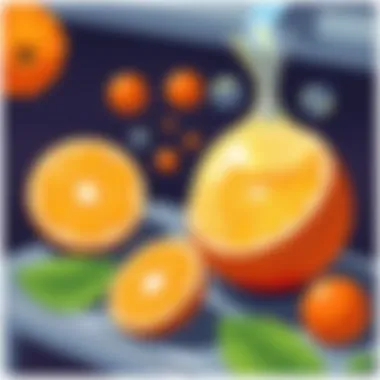Examining Heat's Effect on Vitamin C Stability


Intro
When it comes to our health, vitamins play a vital role in keeping our body ticking like a well-oiled machine. Among these, vitamin C stands out not just for its immune-boosting properties but also for how easily it can be affected by heat. Understanding the dynamics between vitamin C and temperature helps us make smarter choices about what we eat and how we prepare our food.
This investigation will unfold the intricate dance of vitamin C with heat. You’ll learn how cooking methods and temperature can either preserve or destroy this essential nutrient, and what that means for your meals. From boiling to blazing, the effects of heat can vary dramatically and knowing which methods are friendliest to vitamin C may change the way you approach cooking altogether.
So grab a cup of something warm, and let’s explore the sizzling world of vitamin C and heat!
Prelude to Vitamin
Vitamin C, often regarded as a powerhouse nutrient, plays an essential role in our overall health. Its significance stretches beyond mere dietary necessity, touching on various biological functions, from immune support to skin health. This section serves as a gateway into understanding what vitamin C is and why it is a cornerstone of nutrition.
Definition and Role in Nutrition
Vitamin C, chemically known as ascorbic acid, is a water-soluble vitamin pivotal in numerous metabolic processes. It acts as an antioxidant, helping to neutralize harmful free radicals in the body. This function is crucial because free radicals can damage cells and contribute to aging and various diseases. Additionally, vitamin C is vital for the synthesis of collagen, a protein that forms much of our skin, tendons, and ligaments. Without adequate levels of this vitamin, the body may struggle to heal wounds or support tissue health.
Beyond its physical benefits, vitamin C contributes to better iron absorption from plant-based foods and enhances overall immune response. This is particularly important for children, pregnant women, and those who may be at risk of deficiencies due to dietary restrictions or health conditions.
Natural Sources of Vitamin
Naturally abundant in a variety of fruits and vegetables, vitamin C can be easily integrated into diets. Some of the standout sources are:
- Citrus fruits: Oranges, lemons, and grapefruits are widely recognized for their high vitamin C content.
- Berries: Strawberries, raspberries, and blueberries are not only tasty but also packed with this vital nutrient.
- Vegetables: Bell peppers, broccoli, and Brussels sprouts are excellent choices that can enhance your daily intake.
- Other fruits: Kiwi, pineapple, and guava also provide robust amounts of vitamin C.
"A single serving of raw bell pepper can provide more vitamin C than an orange!"
It's worth noting that vitamin C's stability can be influenced by various factors, including exposure to heat, which we will explore in subsequent sections. This understanding of its sources and role creates a foundation for examining how cooking methods may alter its potency and effectiveness in our diets.
These elements strengthen the case for prioritizing vitamin C in daily nutrition and recognizing how heat can impact this essential nutrient.
Understanding Vitamin Stability
Vitamin C, or ascorbic acid, plays a perhaps subtly pivotal role in nutrition and health. Its stability, however, is often compromised by various environmental factors. Understanding the stability of vitamin C not only enhances our grasp of the nutrient itself but also allows for better dietary choices, ensuring that we get the most out of this essential vitamin. This section unpacks the chemical structure of Vitamin C and the influential factors that can undermine its stability.
Chemical Structure of Vitamin
At its core, vitamin C's chemical structure features a six-carbon sugar with multiple hydroxyl (–OH) groups. This configuration renders it a powerful antioxidant, helping to mitigate oxidative stress within the body. The structure also implies a degree of vulnerability; for instance, the double bonds within its molecular makeup are susceptible to alterations under heat. When subjected to high temperatures, vitamin C can undergo thermal degradation, breaking down into less effective and, at times, harmful byproducts. The vulnerability lies in the very molecular traits that make vitamin C beneficial. Hence, comprehending its chemical structure illuminates the critical relationship between this vitamin and heat.
Factors Influencing Stability
Several key elements play a role in the stability of vitamin C. Understanding these factors can aid in maximizing the vitamin's benefits through conscious dietary strategies.
pH Levels
The pH level of a solution is crucial in determining the stability of vitamin C. Generally speaking, acidic conditions favor the preservation of ascorbic acid. When the pH falls below 4.0, vitamin C remains relatively stable. This stability comes from the protonation of functional groups that help maintain its structure. On the flip side, alkaline conditions can lead to degradation. Hence, keeping foods acidic (like citrus fruits) could bolster vitamin C integrity. Using acidifying agents, like lemon juice, can turn an otherwise heat-prone dish into a fortified one. However, it's essential to note that while low pH is beneficial, excessive acidity may also impact the taste and texture of certain foods.
Presence of Oxygen
The presence of oxygen acts like a double-edged sword. While we need oxygen for various metabolic processes, in the context of vitamin C, it can spell disaster. Oxidation is a leading cause of vitamin C degradation. When exposed to oxygen, ascorbic acid readily undergoes changes that render it less effective. This loss occurs at alarming rates when vitamin C-rich foods are stored improperly. Therefore, storing these foods in airtight containers or minimizing exposure to air during food preparation can mean the difference between a nutrient-rich meal and one lacking in essential vitamins. It is a wise choice, albeit requiring a bit of diligence.
Light Exposure
Last but certainly not least is light exposure. Vitamin C is particularly vulnerable to light, especially ultraviolet rays. When exposed, it tends to break down more rapidly, especially in solutions. That's why keeping vitamin C-rich foods in opaque containers or in dark environments can extend their efficacy. The unique feature here lies in the interplay between light and the longevity of nutrients. While light is often associated with freshness in food, it can actually serve as a stealthy enemy for vitamin C.


"When it comes to preserving vitamin C, a little mindfulness can go a long way!"
In summary, understanding the stability of vitamin C encompasses recognizing the chemical structure of this vital nutrient and the various factors that can undermine its efficacy. Adequate pH levels, proper oxygen management, and a keen awareness of light exposure can equip individuals to make informed dietary choices that optimize vitamin C intake.
Effects of Heat on Vitamin
Understanding how heat interacts with vitamin C is crucial for maintaining its integrity in various foods. Heat treatment can significantly affect the concentration and bioavailability of this essential nutrient. It is important for consumers to grasp how different cooking methods can either diminish or preserve vitamin C, impacting their overall nutrition and health. The effects of heat primarily hinge on the degree of temperature applied as well as the duration of exposure.
Thermal Degradation Mechanisms
As we begin to unpack the thermal degradation mechanisms, we realize that vitamin C, also known scientifically as ascorbic acid, has a somewhat fragile nature. When exposed to heat, it undergoes breakdown reactions that ultimately reduce its availability.
- Dehydration: At elevated temperatures, ascorbic acid can lose water molecules, leading to structural changes that may render it ineffective.
- Oxidation: Heat can also promote oxidation reactions, especially in the presence of oxygen. This means that when cooking, particularly at high temperatures, vitamin C runs the risk of transforming into less beneficial compounds.
- Polymerization: Higher temperatures can lead to polymer formation, wherein ascorbic acid molecules bind together, losing their functionality.
These mechanisms serve as a reminder of the delicate balance between cooking and nutrient retention, emphasizing the importance of cooking practices that minimize heat exposure.
Impact of Cooking Methods
When discussing cooking methods, it’s vital to consider how different styles can lead to varying impacts on vitamin C content in foods. Each method comes with its unique characteristics and implications.
Boiling
Boiling is one of the most common cooking methods, often deemed as a straightforward and efficient way to prepare vegetables. However, this method can lead to a significant loss of vitamin C due to leaching into the boiling water. The high temperatures involved in boiling render vitamin C vulnerable, causing rapid degradation. This method stands out as the most detrimental format for vitamin C retention.
- Key Characteristic: The immersion in water exposes food to high temperatures for extended periods, which increases the risk of nutrient loss.
- Advantages: While it’s great for softening food, it often comes at the expense of its nutritional value, showcasing a trade-off in food preparation.
Frying
Frying, particularly deep frying, comes with its own set of pros and cons. The rapid cooking process may lead to less time spent at extreme temperatures, thus theoretically preserving some nutrient value. Still, the heat exposure might result in some degradation.
- Key Characteristic: Frying involves high temperatures, which quickly cooks food but doesn’t completely shield vitamins from heat-induced loss.
- Advantages: Flavor enhancement is significant with this method, and for those who enjoy crispy vegetables, it’s a prevalent choice. However, frying can lead to a moderate loss of vitamin C.
Steaming
Steaming is often regarded as one of the healthier cooking options, aiming to leave nutrients intact while cooking food. The process generally utilizes less heat compared to boiling since food is not submerged in water. This method can maintain vitamin C levels better than its boiling counterpart.
- Key Characteristic: Food is cooked with vapor rather than water, minimizing direct contact that would typically lead to nutrient loss.
- Advantages: Steaming is effective in retaining vitamins, making it a favored method for those looking to maximize their nutrient intake while enjoying cooked meals.
Microwaving
Interestingly, microwaving is a method that often gets overlooked when it comes to nutrient preservation. This cooking modality uses electromagnetic energy to heat food rapidly, thus, often leading to shorter cooking times.
- Key Characteristic: Faster cooking times mean less exposure to heat, theoretically supporting better vitamin C retention.
- Advantages: As a time-saver, microwaving offers convenience without substantially compromising the nutrient profile of food, making it a practical choice for busy lifestyles.
Vitamin Loss in Foods
Understanding the loss of vitamin C in foods is crucial for making informed dietary choices. Vitamin C, or ascorbic acid, plays a vital role in our health, acting as an antioxidant and supporting the immune system. When foods rich in this nutrient are cooked or processed, their vitamin C content can diminish significantly. This decline can impact our overall nutrient intake, making awareness of how heat affects vitamin C indispensable.
Common Foods and Their Vitamin Content
Many everyday foods are packed with vitamin C. Some noteworthy examples include:
- Oranges: Often seen as the poster child for vitamin C, with about 70 mg per medium orange.
- Broccoli: A powerhouse, containing around 81 mg per 100 grams when raw.
- Bell peppers: Especially the red variety, can provide up to 190 mg per 100 grams.
- Kiwi: Surprising to some, but a medium kiwi holds about 71 mg.
- Strawberries: These berries carry roughly 58 mg per cup.


However, it's important to note that the way we cook or prepare these foods can lead to a notable decrease in their vitamin C content. For example, prolonged cooking processes like boiling can lead to up to a 50% loss of vitamin C.
Comparison of Raw vs. Cooked Foods
When we weigh the vitamin C content of raw foods against their cooked counterparts, the differences can be quite striking. Here are a few points to ponder:
- Raw Foods: Eating vegetables and fruits raw often retains more vitamin C. For instance, a raw bell pepper maintains its high levels while cooking can cause significant degradation.
- Cooking Methods Matter: Different techniques affect vitamin C loss differently:
- Boiling: This method can leach nutrients into the water, leading to higher losses.
- Steaming: A gentler approach that can better preserve vitamin C compared to boiling.
"Steamed vegetables can retain up to 60% more vitamin C than those boiled in water."
- Frying: While this cooking method can create a delicious flavor, it's not the best for preserving vitamin C. The high temperatures required can quickly denature the vitamin, reducing its benefits.
Since vitamin C is water-soluble and sensitive to heat, it's clear that cooking has consequences on the nutrient content. Understanding these factors plays a critical role in choosing how to prepare food to maximize its health benefits. Even small adjustments in cooking techniques can make a significant difference in nutrient retention.
Storage Conditions for Vitamin Preservation
Vitamin C is a delicate nutrient that can easily be degraded by environmental conditions. Understanding how to properly store this important vitamin is crucial for maximizing its benefits. When kept in optimal conditions, vitamin C can retain its effectiveness, providing essential health benefits for those who consume it. In this section, we will explore the significance of optimal temperature, humidity levels, and protective packaging to preserve vitamin C content in foods.
Optimal Temperature and Humidity Levels
Temperature and humidity are key players in maintaining the stability of vitamin C. Ideally, vitamin C-rich foods should be stored in a cool, dry place. High temperatures can lead to a faster degradation of this nutrient.
- Cool Temperatures: Storing fruits and vegetables in the refrigerator can help keep their vitamin C levels intact for a longer period. For example, berries, citrus fruits, and green leafy vegetables maintain their potency better when kept cold.
- Humidity: Too much humidity can encourage mold and bacteria growth, which can compromise the quality of food. On the other hand, dry conditions can lead to wilting or dehydration of fresh produce, potentially affecting nutrient levels.
A simple tip to remember: Aim for a temperature range of 32-40°F (0-4°C) for best results in vitamin C preservation. This cooling method helps slow down the chemical reactions that lead to nutrient loss, especially in fruits like oranges and strawberries that are loaded with vitamin C.
"Proper storage can make a world of difference in the vitamin content of your favorite foods!"
Packaging and Protection from Heat
How foods are packaged also plays a significant role in protecting vitamin C from degradation. It's not just about having a good container, but ensuring it shields the food from heat, light, and air.
- Airtight Containers: Using airtight storage containers minimizes the exposure of fruits and vegetables to air, which can lead to oxidation and decrease vitamin C levels.
- Opaque Packaging: Sunlight can break down vitamin C, so using dark or opaque containers to block light can extend the nutrient's life. For instance, storing orange juice in a carton rather than a clear glass bottle helps in retaining more vitamin C.
- Avoid Plastic Wrap: Choosing glass or metal options over plastic is often better for long-term storage, as some plastics can leach chemicals into the food over time, possibly affecting the vitamin content.
Practical Implications for Dietary Choices
The way heat interacts with vitamin C holds real-world significance for dietary choices. Understanding how cooking influences this vital nutrient can help in making informed decisions about food preparation and consumption. Vitamin C is not just another nutrient; it’s a powerhouse when it comes to health. It supports the immune system, aids in collagen production, and acts as an antioxidant. As a result, the preservation of this nutrient should be a priority for those seeking a balanced diet.
When embedding raw foods into everyday meals, or employing effective cooking strategies, one can maximize the dietary benefits of vitamin C. The following sections outline practical approaches to integrating more raw foods into your diet and smart cooking strategies that help in retaining this nutrient.
Incorporating Raw Foods into Diet
Integrating raw foods into diet can be a game-changer. Fruits and veggies, when eaten in their natural state, often retain higher levels of vitamin C. Foods such as bell peppers, kiwi, and strawberries stand tall in the vitamin C department. The key here is freshness. Eating them straight from the fridge or garden minimizes nutrient loss. Not only does this practice boost vitamin C intake, but it also enhances fiber intake, which is crucial for digestive health.
The slight crunch of a fresh carrot or the juicy explosion of an orange may also introduce new flavor dynamics to meals. You don’t have to make drastic changes: consider slicing raw veggies to snack on instead of reaching for chips, or blending fruits into smoothies.
Cooking Strategies to Preserve Nutrients
Short Cooking Times
Cooking methods matter. Short cooking times are touted for their effectiveness in preserving nutrients, including vitamin C. When foods spend less time over heat, there's typically less degradation of vitamins. Stir-frying veggies quickly or blanching them for a minute can retain more nutrients compared to prolonged boiling.


This approach is beneficial as it doesn’t just maintain nutrient levels, it often enhances flavors too. Chopped broccoli, for instance, glistens with flavor just before it wilts away. Keep in mind though, that while nutrient preservation is key, achieving that desired texture and taste is also essential. Thus, utilizing short cooking times holds dual advantages in both nutrition and enjoyment of food.
Lesser Water Usage
Another smart strategy involves the use of lesser water during cooking. When you boil vegetables, significant vitamin loss can happen as the nutrients leach into the water. Using minimal water—like steaming with just enough to create steam—can make a world of difference.
The key feature of this method is that it not only retains more vitamin C but also allows for quicker cooking times. No one wants to be waiting ages for their veggies to cook through! Additionally, less water usage can lead to more vibrant flavors, as the food cooks in its own juices.
Epilogue
All in all, the way we prepare and consume our food profoundly impacts our health. By implementing these practical dietary strategies, you can enjoy foods that are both delicious and nutrient-rich. It's not just what you eat, but how you prepare it that counts!
"Eating raw is not just a fad. It's a celebration of nature's bounty that nourishes the body!"
For more information about vitamin C and its benefits, visit Wikipedia or Britannica.
With these insights, you can confidently traverse your culinary adventures, minimizing heat damage to vitamin C and maximizing its benefits.
Common Myths About Vitamin and Heat
Understanding the common myths surrounding vitamin C and its relationship with heat is vital for anyone looking to enhance their dietary choices. Misinformation can lead to ineffective cooking methods, which in turn may compromise the nutrients essential for health. By clearing the air around these myths, we can make better decisions about how we prepare and consume vitamin C-rich foods.
Debunking Misconceptions
A significant misconception is that cooking any vitamin C-rich food results in complete nutrient loss. While it’s true that heat can degrade vitamin C, the extent of the loss varies depending on several factors including temperature, cooking time, and method used. Not all cooking methods uniformly impact the nutrient degradation. For instance, while boiling can leach vitamins into cooking water, steaming tends to retain more nutrients.
Another common belief is that refrigerated foods maintain more vitamin C compared to room temperature storage. While it's true that cooler temperatures can help preserve nutrients, letting fruits and vegetables sit for prolonged periods can also result in a decline in vitamin C content, particularly if they are not properly sealed or packed.
In short, while heat does affect vitamin C, the relationship is nuanced and often exaggerated.
Scientific Evidence and Studies
Numerous studies have been conducted to examine how heat affects vitamin C stability. For example, research published in the Journal of Agricultural and Food Chemistry highlighted that steaming broccoli leads to a significantly higher retention of vitamin C compared to boiling. This suggests that the method of preparation can have a pronounced effect on the nutrient’s stability.
Furthermore, a comprehensive study demonstrated that certain foods contain higher levels of Vitamin C when blanched rather than fully cooked. This method involves quickly boiling vegetables and then equally quickly cooling them.
"Research shows that cooking methods can either preserve or destroy vitamin C, emphasizing the importance of technique in food preparation."
When it comes to myths about frying, studies show that frying can lead to lesser nutrient retention than steaming or microwaving. However, it should not be overlooked that frying in very high temperatures for prolonged periods will strip most of the nutrients away. Likewise, some theorize that only fresh produce contains sufficient vitamin C, but frozen fruits and vegetables typically maintain a good vitamin C concentration due to the freezing process locking in nutrients right after harvest.
Overall, understanding the science rather than relying solely on hearsay empowers us to make food choices that can optimize our vitamin C intake.
Epilogues and Recommendations
In the exploration of vitamin C and its relationship with heat, it becomes clear that understanding the thermal effects on this vital nutrient is essential for making informed dietary choices. Vitamin C, known for its role in immune function and skin health, is also sensitive to the conditions of cooking and storage. This final section summarizes key insights, outlines practical recommendations, and suggests areas for further research.
Summary of Key Findings
- Heat Sensitivity: Vitamin C degrades at elevated temperatures, making the method of cooking significant in determining nutrient retention. For instance, boiling has been shown to leach more vitamin C than steaming or microwaving due to extended exposure to heat and water.
- Cooking Methods Matter: Each method affects retention differently. Steaming retains more vitamin C than boiling because food is not submerged in water and cooked for shorter time. Microwaving, on the other hand, tends to preserve nutrients due to quick cooking times and minimal water use.
- Raw vs. Cooked Foods: While raw fruits and vegetables provide the highest levels of vitamin C, certain cooking methods can enhance the bioavailability of other nutrients. Balancing raw and cooked options can ensure a nutrient-rich diet.
- Storage Influences: Maintaining appropriate storage conditions, including cool temperatures and dark environments, is key to preserving vitamin C in foods.
"Cooking enhances flavor but can also diminish nutrients—optimize your approach for health benefits."
Future Directions for Research
The landscape of nutritional science is always evolving, and further research into the dynamics of vitamin C under various conditions could benefit dietary guidelines.
- Investigate New Cooking Technologies: Understanding how modern cooking appliances impact vitamin C stability could reshape cooking habits. For instance, air fryers may provide an alternative that retains nutrients effectively.
- Longitudinal Studies on Intake and Health Outcomes: More studies correlating vitamin C intake from different cooking methods with long-term health outcomes will provide critical insights into dietary practices.
- Consumer Education on Nutrient Preservation: Developing educational programs to inform consumers about the best practices for preparing and storing vitamin C-rich foods should be prioritized. This empowers people to make better dietary choices, maximizing nutrient intake and overall health.
For more detailed information, you can check resources such as Wikipedia or educational institutions like Harvard Health.







